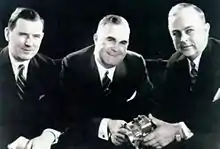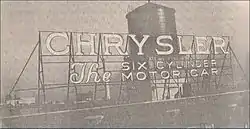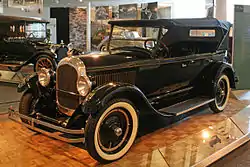The Three Musketeers (Studebaker engineers)
The Three Musketeers is a nickname given to a team of three famous Studebaker engineers, Frederick Morrell Zeder, Owen Ray Skelton, and Carl Breer. They would become the foundation engineers that started the Chrysler Corporation. These three were among the finest engineers that Walter Chrysler surrounded himself with when he started Chrysler Corporation.

History
The nucleus of the engineering team initially formed when Allis-Chalmers Manufacturing Company selected twenty-five university graduates of mechanical engineering to go through their two-year apprenticeship course. Frederick Morrell Zeder and Carl Breer were two such students picked in 1909 and became close friends during the course.[1] Owen Ray Skelton, the third member of the team, was a design engineer with Packard Motor Car Company as a transmission specialist at the time. Zeder first asked Skelton to join him at Studebaker in 1914.[2] Zeder later then asked Breer to join the two of them at Studebaker in 1916, which completed the trio.[3] They became the Zeder, Skelton and Breer Engineering (ZSB) group.[4] Breer went about fixing the mainline engine flaws and the high oil consumption. Skelton worked on a new transmission after discarding their existing transmission. Zeder was in charge of redesigning their existing car and designing new automobiles.[2][3][5] The three had designed Studebaker's successful Light Four, Light Six and Big Six model cars.[6]


Walter P. Chrysler in January 1920 was working for Willys-Overland as their vice president and general manager in Elizabeth, New Jersey. He invited the three engineers, Zeder, Breer and Skelton, to come over to his place from Studebaker. They then moved to Willys-Overland in New Jersey taking a team of 28 Studebaker engineers with them on July 14, 1920.[7] The three engineers were compared by Chrysler to the fictional Three Musketeers, Athos, Porthos, and Aramis.[8] He was referred to as d'Artagnan, the Three Musketeers captain and leader.[2] The three engineers went to work on designing a new car with a new engine in Willys' engineering center in Elizabeth, New Jersey.[9] Their assignment was to fix engineering problems on the existing Willys six cylinder engine car in production and to produce a brand new car design from inside out at the same time. The three engineers determined that the existing six cylinder car was a major redo and obsolete compared to the new cars they had just designed at Studebaker. The new Willys car to come out in 1920 was to be called a "Chrysler" and a colossal sign of incandescent lights spelling this out was built on top of the Willys plant.[9][10]
These plans were halted when the funds set aside for the Chrysler Motors Division of the Willys Corporation Elizabeth plant were discovered to have been depleted by Willys' Toledo branch. Willys was going bankrupt and heading for receivership. Chrysler himself quit his position at Willys in February 1922 in this turmoil of producing the new Chrysler Six automobile. Zeder, Breer and Skelton were embarrassed as they had coaxed a complete team of engineers to go to Willys with them from Studebaker. Studebaker at that time had a plant in Detroit that was doing financially well. The three men, along with several Willys engineers, set themselves up as a consulting firm in Newark, New Jersey, under the name "Zeder Skelton Breer Engineering Company."[11][12]
The Elizabeth plant and the Chrysler Six prototype were sold to William C. Durant in a bankruptcy sale. The plant then built Durant's low priced Star automobile. The Chrysler Six prototype would be made larger, becoming the 1923 Flint automobile, built in Flint, Michigan.[13][14][15] The Chrysler Six was said to be the first modern automobile. Automobile historian Mark Howell remarks that this car is second only to Ford's Model T Ford for its impact on the automobile industry.[16] He claims this car is the dividing line between the old style car and the modern automobile.[17] Chrysler's first luxury car was priced at an affordable $1,565.[18]

Chrysler negotiated a four-year management contract with Maxwell Motor Corporation on June 1, 1923.[19] One of the first things he did as their new chairman was to ask engineers Zeder, Skelton, and Breer to close their consulting firm in New Jersey and come to Detroit with him. They were to do all the engineering work for the Maxwell and Chalmers cars and design a new Chrysler automobile. They agreed and arrived in Detroit on June 6, 1923.[20]
There in 1924 Chrysler launched his own version of the Chrysler six-cylinder. The Chrysler car was financially successful and in 1925 the Maxwell car company became the Chrysler Corporation.[21][22] The "lightning flashes" on the Chrysler logo were actually Zs, a tribute to Fred Zeder.[23] This logo was used on the first Chrysler automobile built in 1924 and, off and on, for years thereafter. Zeder designed cars as an engineer technologist using mathematical laboratory parameters under controlled conditions as a university trained engineer.[24][25][26]
References
- Yanik 1995, p. 1.
- Wright, Kelsey (1998–2000). "Owen Skelton, Executive Engineer". Allpar; allpar.com. Retrieved 13 December 2012.
- Zatz, David (1998–2000). "Carl Breer, Executive Engineer". Allpar; allpar.com. Retrieved 13 December 2012.
- Yanik 1995, p. 31.
- Yanik 1995, pp. 60-69.
- "Carl Breer, one of Chrysler's Three Musketeer". Allpar; allpar.com. 2020. Retrieved 7 December 2020.
- Hyde 2003, p. 17.
- Severson, Aaron (2011). "Changing Winds: The 1934-1937 Chrysler and DeSoto Airflows". Retrieved 13 December 2012.
- Yanik 1995, pp. 65-70.
- Weiss 2003, pp. 119-124.
- Yanik 1995, p. 70.
- Curcio 2001, pp. 281-282.
- Weiss 2003, p. 122.
- Yanik 1995, pp. 71,72.
- Kulchycki, T.L. (2000–2007). "The Flint Catalog". Archived from the original on 21 January 2013. Retrieved 13 December 2012.
- Curcio 2001, p. 317.
- The Beginning of it all: The 1924 Chrysler Six
- Curcio 2001, p. 315.
- Yanik 2009, p. 146.
- Yanik 2009, p. 147.
- Yanik 2009, pp. 157-158.
- "The 1931 Plymouth PA: Walter Chrysler's Fistful of Aces". 2000–2007. Retrieved 13 December 2012.
- Weiss 2003, pp. 125,126.
- Wright, Kelsey (2001–2012). "Fred Zeder, Vice President in Charge of Engineering". Allpar; allpar.com. Retrieved 13 December 2012.
- Chrysler Institute of Engineering
- Curcio 2001, p. 270.
Bibliography
- Curcio, Vincent (2001). Chrysler: The Life & Times of a Genius. Oxford University Press. ISBN 0195147057.
- Hyde, Charles K. (2003). Riding the Roller Coaster. Wayne State University Press. ISBN 9780814330913.
- Weiss, H. Eugene (2003). Chrysler, Ford, Durant: Founding Giants of Automotive Industry (illustrated ed.). McFarland. ISBN 0786416114.
- Yanik, Anthony J. (1995). The Birth of Chrysler Corporation - Its Engineering Legacy. Society of Automotive Engineers. p. 146. ISBN 1560915242.
- Yanik, Anthony J. (2009). Maxwell Motor: the Making of the Chrysler Corporation (illustrated ed.). Wayne State University Press. ISBN 0814334237.
